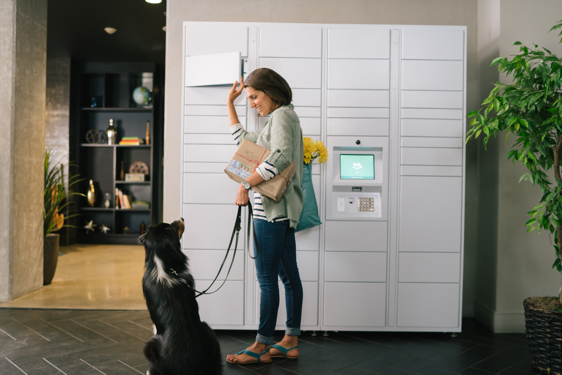NELSON Worldwide Announces New Senior VP and Managing Director
Award-winning architecture, design, and strategy firm NELSON Worldwide, announced the addition of Haril A. Pandya, FAIA LEED AP, as Senior VP and managing director of the Boston office. Read more here.
Travel + Leisure: Hilton’s New Hotel Brand Aims to Make Overworked Millennials’ Lives Easier
Hilton unveiled today a new hotel brand built for what the company calls “modern achievers,” who are interested in getting the most out of life while not spending too much on their hotel room. Read more here.
Finance & Commerce: Top Projects of 2021
“Every year, the projects seem to increase in creativity, level of difficulty and innovative construction techniques. We are proud to honor the best building and #construction projects in Minnesota.”— Bill Gaier, Publisher of Finance & Commerce
We’re honored to share that our projects with Bell Bank and Two22 Tower in downtown #Minneapolis have been recognized in Finance & Commerce’s Top Projects of 2021 and each took home a Top Project award! Thank you and congratulations to all of our talented teammates and partners. See the full list of Top Projects here.
NeoCon: Agility is critical in the hybrid workplace
Teammate Chen Hui Spicer shares her experience as a first-time BEST OF NeoCon judge this year and the product that resonated most with her and her work at NELSON. Read more with NeoCon here.
Philadelphia Style: Philadelphia’s top home industry professionals
Thanks to these top local architects and designers, Philadelphians can call a stylish, chic and innovative city home. Read more with Philadelphia Style here.
VMSD Magazine: Footwear Stores are Embracing New Trends to Capture Customers
MCD: New Main Line Health’s Women’s Health Center Promotes Holistic Wellness
Main Line Health’s newest women’s outpatient center, located near rapidly growing residential areas in King of Prussia and Valley Forge in Philadelphia offers a holistic wellness experience for patients and visitors. From physical and mental health treatment spaces, to a demonstration kitchen for healthy cooking classes, the facility offers community engagement, wellness, and healing, all under one roof. Read more here.
Business of Home: Pollack’s new CEO, Kravet appoints a marketing creative director and more
Minneapolis-based architecture and design firm Nelson Worldwide appointed Joseph Muscarella as Vice President of Client Development and David Crotty as Regional Practice Leader of the Civic, Community, Justice and Education Practice.
Read more with Business of Home here.
The Amenity Effect: Making your Office Building More Marketable
Amenities have a profound effect on the value of a building, and new unique experiences make a lasting impression for consumers, employees, hotel guests, and residents. Our mixed-use teammates set out to explore current and future amenity trends in our latest blog series, The Amenity Effect. Follow along as we dive deep into the environments where we work, shop, live, and thrive and take a closer look at the amenities that help make these environments flourish.
___________________________________________
When I graduated from Oregon and moved to San Francisco to begin my career in architecture, it was at the peak of the dotcom era. Every other person I met was working for a startup of some sort with stories of ping pong tables, open refrigerators, drink carts, and skateboards in their offices. The dotcom parties we attended were epic with each startup trying to outdo the next, as the city was breeding a culture of having fun at work. Elementary school kids were trading in the vision of becoming a doctor or lawyer for a job at Google because of the perks that it came with. Corporations took note and began adopting the fun at work mentality, by saturating their office buildings, headquarters, and corporate campuses with amenities.
When it comes to workplace amenities, there isn’t just one magic formula. Developers and landlords can get creative with the route they want to take, but what matters most, is incorporating brand-centric amenities that complement the surrounding community and overall purpose of the building.
Here are three examples of different approaches to building amenities and their effect on the value of the facility:
1. Multi-tenant building with a central amenity hub
Some savvy developers have seen opportunities to acquire multi-building commercial office parks with little to nothing in common and transform them into campuses like those corporate and tech headquarters. They recognized the trend for hospitality inspired environments in universities that are nurturing our future workforce and the need to provide comparable environments in the real world. Sure each building could be outfitted with its own checklist of amenities, but these developers are aspiring to bring the multi-tenant buildings together with a centralized amenity hub.
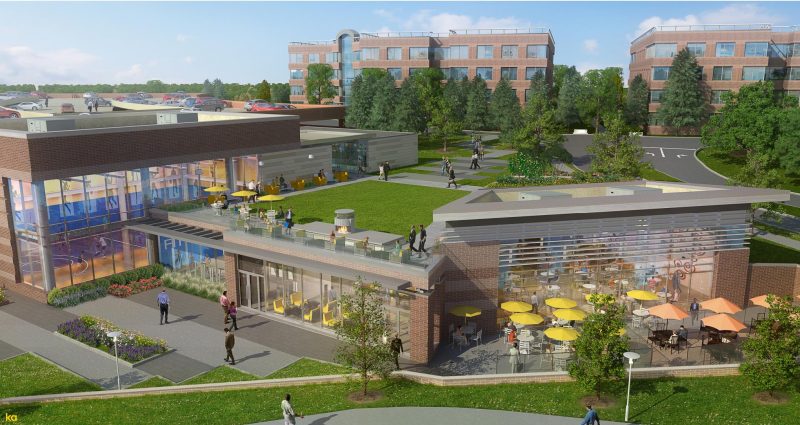
Warren Corporate Center – Warren, NJ
Warren Corporate Center in Warren, New Jersey is an example of a suburban multi-building, mixed tenant property that we helped reposition as a unique amenity-rich campus with dining, fitness, sports, conferencing, and workplace wellness offerings. NELSON capitalized on a central location for the amenity building, creating strong indoor-outdoor connections through transparency. The push and pull of building forms encourages visitors to wander into the building and explore the green roof plaza and views inside and out. A variety of gathering spaces offer visitors a new level of hospitality and reasons to stay longer for group meetings, individual work sessions, or corporate functions. The design elevated the quality of architecture and amenity space with the objective of attracting better tenants and encouraging current tenants to engage with a campus community.
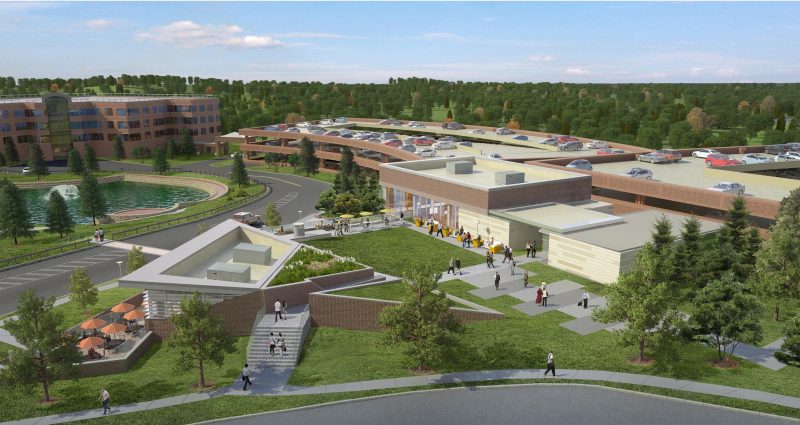
Warren Corporate Center – Warren, NJ
2. Social hub for wellness, collaboration, and after-hours activity
There are also opportunities to expand upon the more traditional fitness, conferencing, and dining amenities by positioning a facility as a social hub for wellness, collaboration, after work happy hours, and sports leagues.
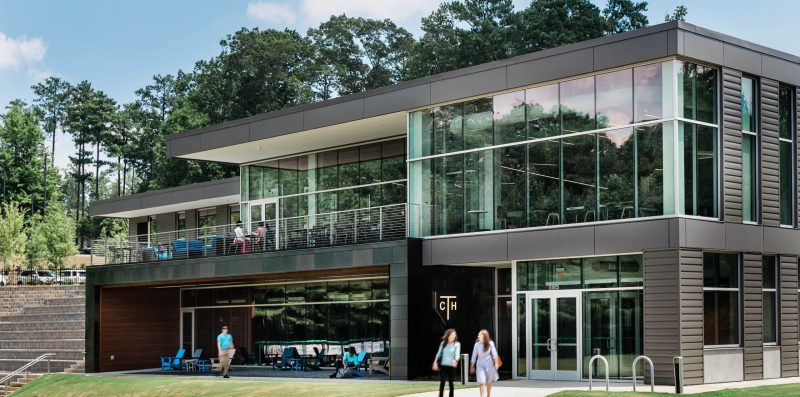
Sanctuary Park – Alpharetta , Georgia
Our approach in Alpharetta, Georgia was to position a new two-story building into the existing hillside to take advantage of the topography and maximize views to the natural surroundings and very active softball field. A terraced amphitheater provides both space for softball spectators, as well as causal seating and open-air meetings. Dining, lounging, and recreation spaces were arranged along a grand outdoor terrace that overlooked the ballfield, with all-glass walls to reinforce indoor-outdoor connections and provide natural light and stunning views throughout. A well-equipped fitness center is tucked into the lower level which features a high-end cardio and weight gym, classrooms, and spa-like locker and shower facilities to fulfill the cornucopia of centralized campus amenities.
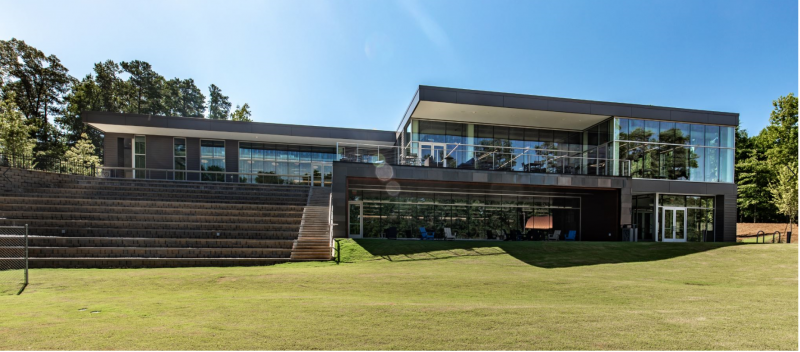
Sanctuary Park – Alpharetta , Georgia
3. Storied destination with outdoor and local flare
Storytelling can be a huge influence for leasing and attracting a tenant who seeks to provide an authentic environment for their employees. Adding outdoor elements and local flare can also add value. As crowded fitness centers, classrooms, and cafes hit pause for a while post-COVID-19, and more people continue to work from home, it will be necessary to provide a safe work environment.More thought and effort should be focused to evolving and merging the physical confines of a structured building with the fresh openness of the outdoors. Trails, walking paths, bike share programs could couple with covered outdoor working opportunities. Perhaps extended stay hospitality will make its way to these amenity buildings in the form of on-campus micro-suites that could provide for safe and convenient overnight stay and work opportunities for traveling employees, consultants and clients. Wherever the amenity game leads us, we as designers, owners and developers can seek to provide a blended biophilic connection of comfort, privacy, flexibility, inspiration, and efficiency in the way we work.
Latitude in Parisspany, New Jersey is an example where proximity of the existing buildings to I-80, helped inspire our branding and design teams to adopt a metaphor of coast-to-coast connectivity and the American landscape in the branding and design of the renovation. The main focal element of the project was the glass-enclosed space that would connect the two separate buildings to create a figurative crossroad for the entire property. A grand stair in the space responds to the site’s topography, reinforces outdoor connections, and provides the defining social gathering space for the campus.
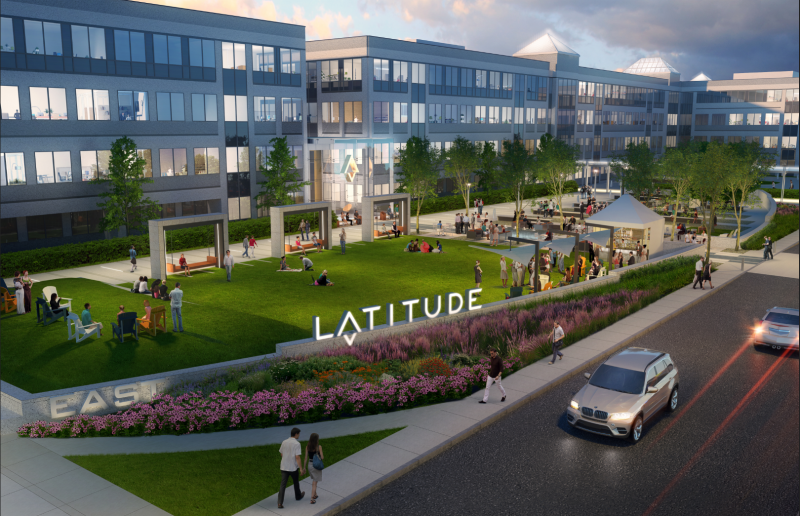
Latitude – Parsippany, New Jersey
The underutilized, long, linear landscaped area along the buildings has been re-imagined as a variety of outdoor amenity spaces that reinforce the coast-to-coast concept with elements that reflect vernacular imagery from across the country and offer options for events, recreation, individual reflection, spontaneous interactions, and collaboration.
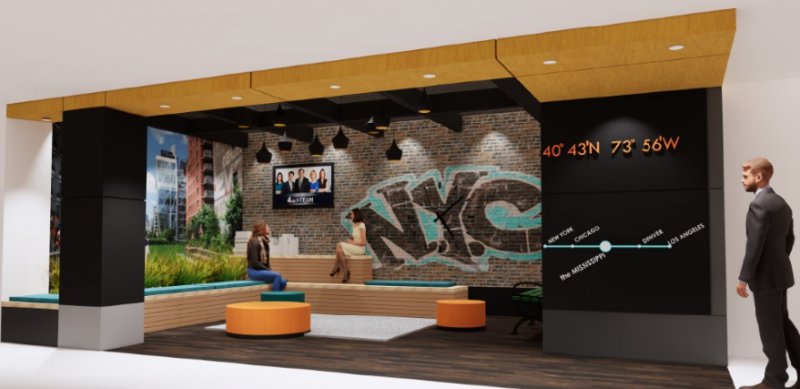
Latitude – Parsippany, New Jersey
The amenity effect for workplaces goes beyond recruiting and retaining employees. Whether a space is meant to connect tenants and inhabitants, inspire wellness and socialization, or tell a brand’s story, amenities are the valuable tools that grab attention and keep people coming back and engaged while they’re there.
The (New) Experiential Amenities
The amenity war rages on, but today’s workplace offerings have never been more wide-ranging. From virtual programming to convenience-based apps, employers looking to differentiate are having to reimagine what constitutes an amenity. The pandemic has shifted consumer behavior and the role of the workplace and soon it will be up to brands to create a differentiated foundation for programming, engagement, and collaboration that employees not only want to return to but cannot be replicated at home. The traditional definition of amenities will expand to support lifestyles – both in and outside of the physical office – and successful future perks will be a blend of digital offerings and experiential environments.
Virtual Equity
From virtual coffee meetings to subsidizing health-related apps, employers are using tech to keep staff connected with more dynamic teams than ever before. The pandemic has created a new blended workplace that will need to thrive for future company success. And that means not only offering virtual amenities, but providing those that better help bridge the gap between the remote worker and the physical office. Consider social networking apps like Houseparty that encourage serendipitous video chats between blended teammates or virtual office platforms like Cosmos that add a layer of gaming to employee collaboration, allowing users to actually create a custom aviator. There are plenty of options, find a solution that fits your unique brand to better address the future of dynamic collaboration for all teammates.
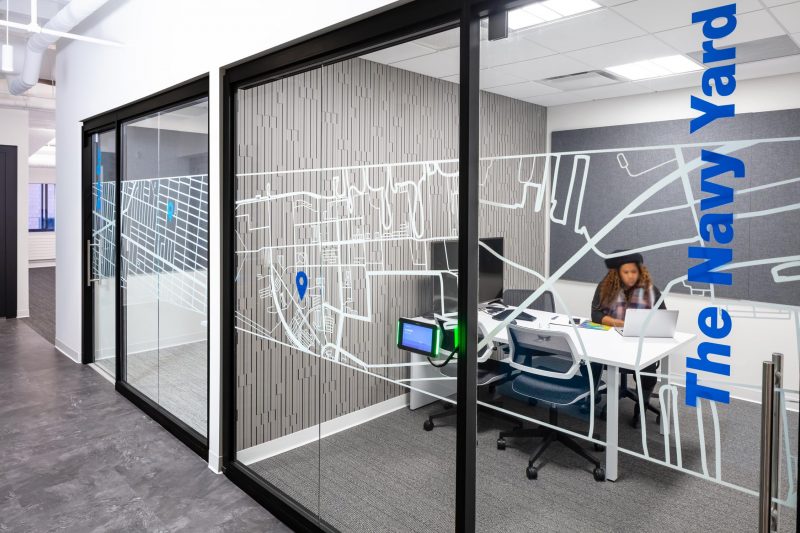
Flexible Futures
Amenities can’t be a one-size-fits-all solution, the offerings must allow employees to customize based on their needs, job responsibilities, and even region. While teammates in urban settings may prioritize an app that expedites their commute, like a membership to RideAmigos or JumpBikes, employees in the suburbs might prefer an on-site yoga room or Zoom studio. Consider conducting employee surveys to understand your teammate breakdown to provide more relevant offerings. Employee satisfaction will stem from feeling in control of their environment – especially after such an out-of-control year. The more choice you can offer teammates, the better position you’ll be in to attract and retain top talent.
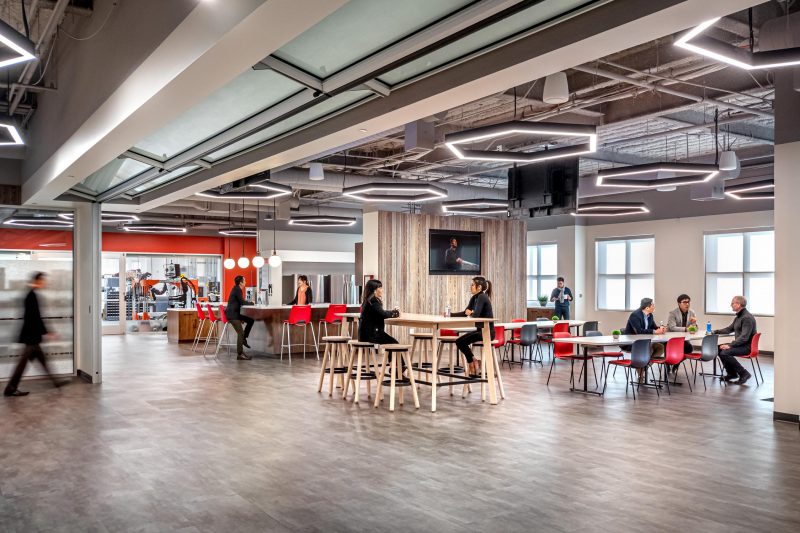
Innovate F&B
Brands will need to get creative to offer a differentiated food and beverage experience for their employees, with safety in mind. Consider win-win partnerships with local restaurants, food trucks, catering apps like Relish, and even cloud kitchens, to offer employees unique, localized food offerings in a more controlled environment. Create dedicated drop-off zones for food delivery with warming drawers, refrigerators, and disposable utensils to reduce touches and streamline the process.
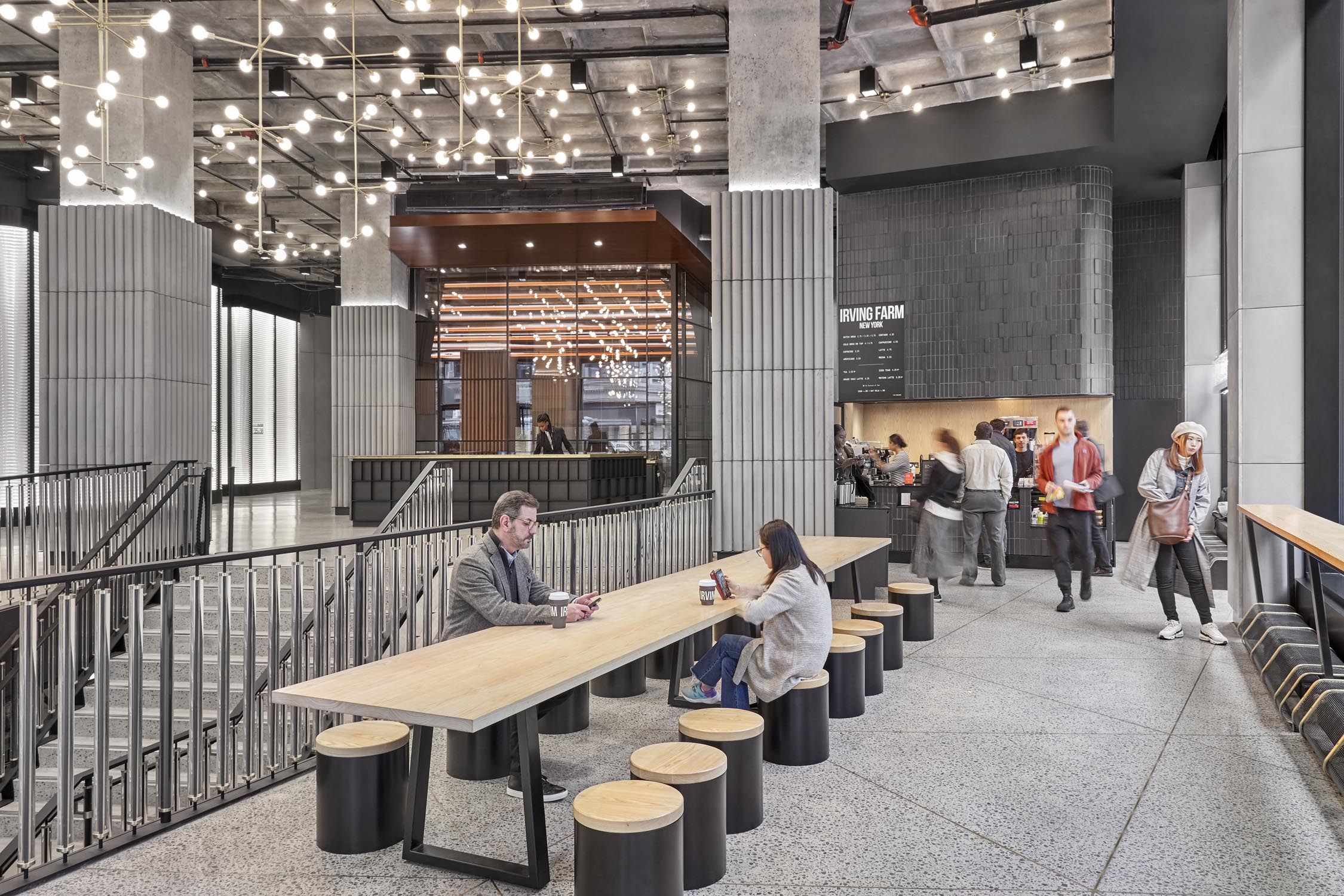
All Season Entertainment
With so many employees embracing the working from home experiment, the role of the office is shifting. While heads-down work can easily be accomplished at home, the office will be need to be transformed into a social destination – an experiential hub for brands, dedicated to hosting clients, encouraging employee engagement, and facilitating teammate collaboration – and amenities will need to follow suit. Consider creating more elevated, year-round spaces that can flex depending on the occasion (don’t forget after-hour usage) and get employees excited about an excuse to return to the office.
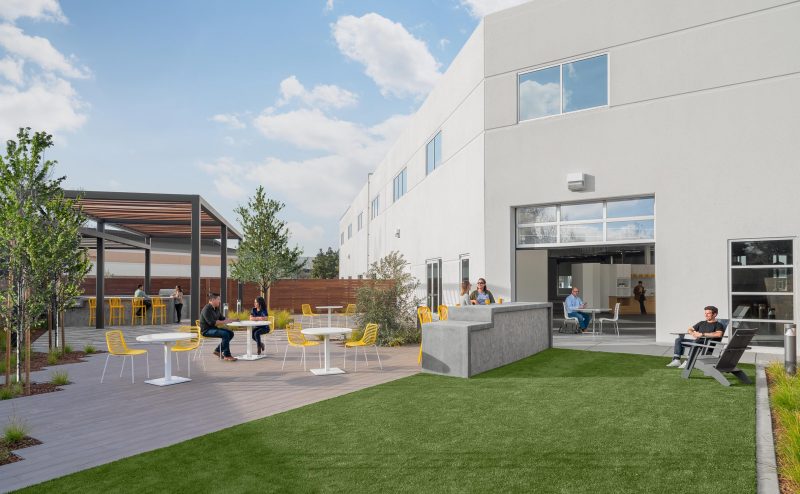
Wandering Wellness
A healthy lifestyle is nothing new, but a renewed focus on holistic, outdoor wellness will reign supreme in the coming years. Create differentiated amenities like hiking trails, dedicated meditation areas, or artificial turf for multi-purpose events and activities, to allow your employees to unwind and recharge in a safe environment. If you’re short on square footage, consider app subscriptions for on-demand content like Headspace, LulaFit, or Peloton.

Elevated Convenience
During the pandemic, most consumers quickly adjusted to relying on amenities once thought to be indulgent. From grocery delivery to virtual doctor visits and direct-to-consumer movie screenings, we became reliant on these elevated services at the touch of a button. This increased expectation on convenience will not go away with the pandemic and employers will need to address this learned behavior with frictionless offerings for employees. Think of concierge service-type apps that can schedule doctor appointments, food delivery, dry-cleaning, order office supplies or corporate gifts.
